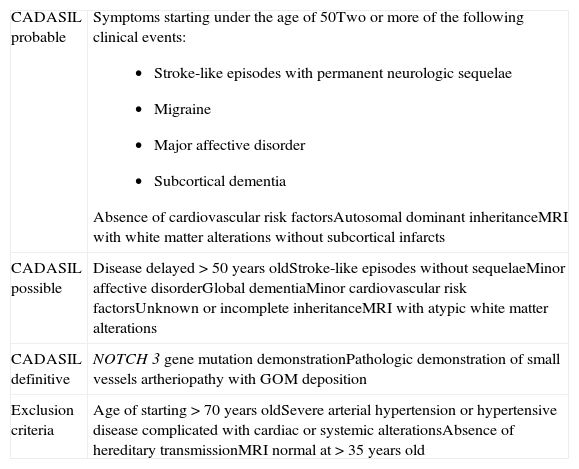CADASIL (cerebral arteriopathy, autosomal dominant, with subcortical infarcts and leu–koencephalopathy) is an infrequent inherited disease that could have anesthetic implica–tions. However these have rarely been reported. We present a male patient previously diagnosed with CADASIL, who had suffered an ischemic vascular cerebral accident with a MRI compatible with leukoencephalopathy, and who was dependent for daily activities, and sustained dementia, mood alterations, apathy, and urine incontinence. He had famil–ial antecedents of psychiatric symptoms and ischemic stroke events in several relatives including his father, two brothers and one sister. He was scheduled for arthrodesis of the left knee because of multiple infectious complications of prosthetic knee surgery. He was under clopidogrel treatment which was withdrawn seven days before surgery. The pro–cedure was performed under combined spinal-epidural anesthesia, intraoperative seda–tion with midazolam, and postoperative multimodal analgesia including epidural patient controlled analgesia. The perioperative management was uneventful and we outline the adequacy of managing these patients under regional anesthesia and analgesia, as these permit to maintain hemodynamic stability leading to adequate cerebral perfusion, key to avoid an increase in the effects of the chronic arteriopathy patients with CADASIL sustain
CADASIL (arteriopatía cerebral autosómica dominante, con infartos subcorticales y leu–coencefalopatía) es una enfermedad hereditaria poco frecuente que puede tener impli–caciones anestesiológicas, escasamente comunicadas. Presentamos el caso de un varón, previamente diagnosticado de CADASIL, que había sufrido un accidente cerebrovascular isquémico, con resonancia magnética compatible con leucoencefalopatía, y estaba muy limitado para las actividades diarias, con demencia, alteraciones del comportamiento, apatía e incontinencia urinaria. Entre sus antecedentes familiares, había varios parientes con síntomas psiquiátricos y accidentes cerebrovasculares, como su padre, dos hermanos y una hermana. Programado para artrodesis de la rodilla izquierda por complicaciones infecciosas tras cirugía de prótesis de rodilla, estaba tomando clopidogrel, que había sus–pendido 7días antes. Se empleó anestesia combinada epidural-subaracnoidea y sedación intraoperatoria con midazolam, así como analgesia multimodal en el postoperatorio que incluyó analgesia epidural. No hubo incidencias notables. La anestesia y la analgesia epi–durales permitieron mantener la estabilidad hemodinámica para una perfusión cerebral adecuada, clave para no empeorar los efectos de la arteriopatía crónica en la CADASIL.
Artículo
Comprando el artículo el PDF del mismo podrá ser descargado
Precio 19,34 €
Comprar ahora








